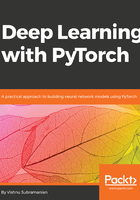
Deep dive into the building blocks of neural networks
As we learned in the previous chapter, training a deep learning algorithm requires the following steps:
- Building a data pipeline
- Building a network architecture
- Evaluating the architecture using a loss function
- Optimizing the network architecture weights using an optimization algorithm
In the previous chapter, the network was composed of a simple linear model built using PyTorch numerical operations. Though building a neural architecture for a toy problem using numerical operations is easier, it quickly becomes complicated when we try to build architectures required to solve complex problems in different areas, such as computer vision and natural language processing (NLP). Most of the deep learning frameworks, such as PyTorch, TensorFlow, and Apache MXNet, provide higher-level functionalities that abstract a lot of this complexity. These higher-level functionalities are called layers across the deep learning frameworks. They accept input data, apply transformations like the ones we have seen in the previous chapter, and output the data. To solve real-world problems, deep learning architectures constitute of a number of layers ranging from 1 to 150, or sometimes more than that. Abstracting the low-level operations and training deep learning algorithms would look like the following diagram:

Summarizing the previous diagram, any deep learning training involves getting data, building an architecture that in general is getting a bunch of layers together, evaluating the accuracy of the model using a loss function, and then optimizing the algorithm by optimizing the weights of our network. Before looking at solving some of the real-world problems, we will come to understand higher-level abstractions provided by PyTorch for building layers, loss functions, and optimizers.